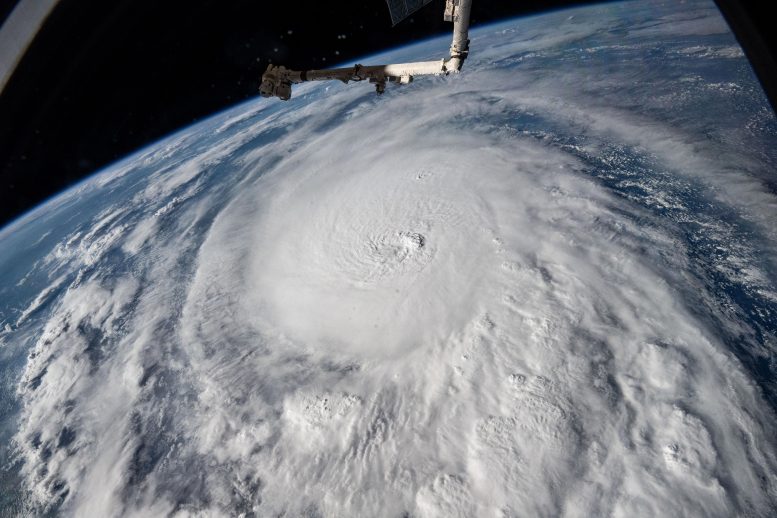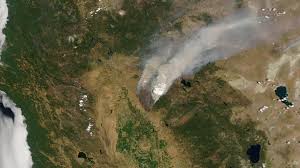On September 27, 2024, Helene made landfall on Florida as a Category 4 hurricane. It was the 2nd hurricane to hit the state of Florida, bringing with it high, strong winds and flooding throughout the several regions of the state. Millions of people had to evacuate in order to be secure from these dangers that Helene brought, leaving their homes and businesses behind. The aftermath of Hurricane Helene resulted in these homes and businesses being destroyed, while hundreds of other people being dead or missing as a result of the flooding, together with billions of dollars lost in property and infrastructure damage, costing the state a fortune to fix these problems and provide for the affected.
As the people of Florida were recovering from hurricane Helene, on Saturday, October the 5th, Milton, a tropical depression had appeared over the Gulf of Mexico. Yet, just hours after its formation, the National Hurricane Center (NHC) deemed it a tropical storm. And on Sunday afternoon the next day, Milton was categorized as a Category 1 hurricane, rapidly intensifying its power over the Gulf of Mexico.
Furthermore, by the end of Monday, October 7th, Milton had rapidly intensified into a Category 5 hurricane. Milton went from a Category 1 to a Category 5 hurricane in the span of 24 hours, it had winds up to 180 mph and the pressure went down to 897 mb. This was one of the fastests intensifications yet, and now it presented itself as another threat for Florida, just 2 weeks after the people of Florida had experienced Hurricane Helene.
How did this happen?
Hurricane Milton’s rapid intensification was a surprise for a lot of people, especially those analysts and researchers following Milton’s path through the Gulf of Mexico. Plenty of them were equally terrified and amazed at how fast Milton was evolving through the Gulf of Mexico, going from tropical depression, to a tropical storm, to a Category 1 hurricane and then to a Category 5 hurricane in just less than a week. Yet, this rapid intensification will not end with Milton, it’s going to become more and more common, presenting a future problem for Florida and future hurricanes.
But how was Milton able to intensify and grow in such a short span of time? It has to do with certain factors, but the two most important are the rising temperatures in the water that affect how much warm, humid air is present in these waters.
Hurricanes form as low air pressure that causes warm, humid air from the oceans to rise in the iconic spiral shape. As this warm air rises, it releases heat, it cools down and forms bands of clouds that will soon become storms. The low air pressure continues to pull more warm air and the spiral gets more intense. And the cycle continues, until there is no more warm, humid air to suck on, then, the storm loses its “fuel” and starts to degrade.
Therefore, the main component that fuels these storms into becoming hurricanes is warm, humid air. This is why the Gulf of Mexico is one of the most common regions in the world where hurricanes make their appearances and pose a threat to land around it. The water in it contains lots of warm, humid air that is available for storms to acquire and turn into dangerous hurricanes.
Milton formed as any other storm in the Gulf of Mexico, it sucked up the warm, humid air in the waters, fueling itself and becoming stronger. In spite of that, its rapid intensification was attributed to rising water temperatures in a phenomenon known as “marine heat waves.”
To explain, a marine heat wave is a period of time when the temperature of the oceans increases significantly over their normal level, leading to increasing temperatures over the waters over their normal temperature range. These can last days, weeks, months and in the most extreme cases, years. Marine heat waves have been occurring for years, the problem now is that they are now becoming more and more common as a cause of climate change. As global temperatures increase, so does the water’s temperature, leading to more marine heat waves that raise the temperature to the water even higher and waves that last even longer.
Right now, the Gulf of Mexico is experiencing a marine heat wave, which has increased the water’s temperature over its regular temperature range. This is the reason why Milton grew in force in such a short period of time. The current heat wave gave Milton tons and tons of extra warm, humid air as it was passing through the Gulf of Mexico. As a result, Milton grew large in size, produced much more powerful storms, while intensifying its strength. This is why hurricane Milton went from a Category 1 to a Category 5 hurricane in no less than 24 hours.
Response To Milton’s Rapid Intensification
The rapid intensification of Milton was reported immediately throughout the media. Milton, now a Category 5 hurricane, presented a serious threat to the surrounding areas, especially mainland Florida. If it continued to increase in power like this, the destruction that it would cause would be vastly enormous, destroying thousands of homes, potentially killing hundreds of residents and leaving Florida with billions of dollars lost in damage.
In Florida itself, almost a million people started to evacuate to other areas of the state where Milton didn’t present a threat, several others decided to get out of the state entirely in order to be much safer.
Nevertheless, this large evacuation of people had its problems, several roads were filled with a lot of traffic as residents were trying to get out of the danger zones. A handful of gas stations were running low on gas, those who desperately needed the fuel to evacuate out of the danger unfortunately didn’t get any and had to resort to other methods to evacuate.
The Tampa Bay Area was one of the main areas where people were told to evacuate, high winds and inches of flood were expected in cities like Tampa and St. Petersburg, putting at risk the lives of almost 3 millions people who live in this area.
In regards to this, the state of Florida prepared various efforts to be able to help those in need, and minimize damage to property and infrastructure.
The Florida National Guard was put into action, 5,000 service members on duty in case of emergency, with resources such as medical supplies, food and water ready to help those in need as the hurricane approached Florida.
Rescue teams were put into place as Milton approached with the required equipment of airboats in case of extreme floods and four wheel vehicles to traverse the rough terrain, in search of people in extreme situations and aiding them.
Multiple hospitals, adult family care homes, nursing homes and other types of facilities were available to the public to provide the necessary resources if needed, whether it be for them to reside while Hurricane Milton passes through Florida or to provide medical care for those affected by the aftermath of Hurricane Milton.
To minimize and avoid infrastructure damage, teams were put into place with several equipment to inform about the possibility of certain infrastructure being destroyed with the aim of discovering the possible cost of these damages and how long it would take for the state of Florida to gather the necessary resources to fix and make this infrastructure available again.
At last, a clean up team was put together with a series of heavy equipment/machinery such as bulldozers to aid clean up the streets of all of the rubble that Hurricane Milton would leave in its aftermath. This would help the streets become much more accessible for the public and the necessary resources to flow into the most affected areas.
This and much more was enacted by Governor Ron DeSantis of Florida to provide aid, relief and preemptive measures to secure the safety of its citizens before days of Milton making landfall.
Landfall of Milton
Even before Hurricane Milton made landfall on Florida, an event rather surprising was already causing havoc in the state. Several F3 tornadoes started to make their appearance in several areas of Florida, caughting people by surprise as they were only preparing for the high winds and flooding that Milton would bring, not for these tornadoes that were now ravaging the homes of many.
Around 8:30 PM, October 9th, as the last tornadoes and twisters disappeared, Hurricane Milton made its landfall near Siesta Key, in Sarasota County. Fortunately, Milton’s power had diminished as it traveled to Florida, impacting only as a Category 3 hurricane.
Still, Hurricane Milton had winds up to 120 mph and inches of water were pouring into the areas such as the Tampa Bay Area, specifically coastal cities like St. Petersburg was the most affected by Hurricane Milton. Inundating thousands of homes, while sustaining high and strong winds up to 100 mph.
These high winds were ripping the roofs of thousands of homes, and destroying crucial businesses and infrastructure that would cost the state of Florida billions of dollars to compensate those who lost their homes and businesses but also to repair this crucial infrastructure that would be important for the aftermath of this hurricane.
Aftermath Of Milton
As Hurricane Milton traveled through Florida, its power started to deteriorate until Milton decreased into a category 1 hurricane, and it turned again into a tropical storm as it entered the Atlantic ocean.
In the immediate aftermath of Milton, it left almost 3 million residents across the state without any electricity, putting them in the dark for hours; for others, they were left without power for days. Meaning that communication was, for some time, difficult between residents. But as of right now, more and more people are regaining their electricity throughout the state.
Not only electricity, but fuel was another problem that was present in the immediate aftermath of Hurricane Milton. Almost a million people were out of gas in the state of Florida and needed the assistance of the state government to provide them with any fuel that was available for them to use in order to get out of the affected areas. By now, it was announced that Governor Ron DeSantis is giving 10 free gallons of gasoline to Florida residents from state-run fuel sites.
As well, hundreds of rescue missions took place in the immediate aftermath of Hurricane Milton. These rescue missions mostly took place in areas where the floods had a great impact, such as in St. Petersburg where almost 18 inches of water had flooded the city. In one situation, a rescue team spotted a 14 year old floating, gasping for air, in the flood waters of Tampa. In a different situation, a rescue team was able to spot a man hanging from a cooler, floating off the coast of Florida. Fortunately, both the 14 year old and the man were able to be rescued by these rescue teams and were brought to safety.
Yet, others weren’t able to be saved in time, and perished during Hurricane Milton’s landfall through Florida. In St. Lucie County six deaths were attributed to the tornadoes. In St. Petersburg, police confirmed two deaths related to the storm. Volusia County and Tampa also suffered several casualties. For now, the total death toll of Hurricane Milton is 16 people, still, more are expected to be found in the next few days.
Regarding property and infrastructure damage, it is estimated that the total economic loss is between $160 billion and $180 billion. FEMA has already been put into action, working together with the state of Florida and the local governments to help those affected, but also to make roads, ports, bridges, airports and more crucial infrastructure available to the public again.
Even as these efforts between FEMA and the state of Florida continue to work together and are spending large amounts of resources and money to help those that have been affected by Hurricane Milton, as people have lost friends and family members and the state is putting itself back up, others took the opportunity to use this situation for their own interests, especially in politics.
Former president Donald Trump has accused current president Joe Biden of using FEMA relief money towards issues relating to immigration in order to undermine the Biden administration, and his current vice president Kamala Harris, who is also one of the candidates and Trump’s opposition in the next presidential election.
President Joe Biden, as he was visiting Florida in order to survey Milton’s damage throughout the state and Vice-president Kamala Harris denied the previous accusations made by former president Donald Trump and have responded to him, stating that Trump should not be spreading this kind of misinformation. FEMA relief money is being used to aid Florida, to put the state, its residents and all of its infrastructure back into motion.
Conclusion
Milton was the third hurricane to hit the state of Florida this season. It started as any other hurricane, even so through climate change, it was able to become dangerous in just a matter of days. This rapid intensification endangered the lives of millions in the peninsula, and put at risk the property they’ve earned throughout their hard years of work.
If these rising temperatures keep continuing, it will present a problem for future hurricane seasons. Marine heat waves will become more common and will last for much longer, affecting how hurricanes form and intensify. Hurricanes will grow and become stronger in much shorter periods of time, just as Milton did this season.
And unfortunately, the impact of climate change through Hurricane Milton is now being seen in the state of Florida. Thousands of people were forced to evacuate and leave their homes unprotected against the storm. Hundreds of homes have been destroyed, roads were flooded, people have lost friends and families, infrastructure has been damaged which means billions of dollars have been lost and tons of resources are now needed to reinstate this infrastructure and people’s property across the state.
Even as these problems become much more evident and the results are being experienced at this moment, certain still deny climate change being an important issue and factor in the formation of stronger hurricanes. Former President Donald Trump and Florida Governor Ron DeSantis have denied that climate change or anything related to it had been a factor in Milton’s rapid intensification and impact in Florida.
If we want to prevent these kinds of events from becoming frequent every year, admitting that climate change is a great factor in making these hurricanes stronger is the first step. Without admitting this, no progress will be made to prevent the increasing rate of global temperatures. With Hurricane Milton, its rapid intensification was a surprise, however, as we move into the future, denying climate change and its effects, these rapid intensifications will become more and more common, proving dangerous for places like Florida in the future, putting at risk the lives of millions of people.








